 Image search results - "America" Image search results - "America" |

The most prominent cherry blossoms from Washington, DC are the Somei-Yoshino cherry blossoms named "America." They bloom in late March along Shin-Shibakawa River.
|
|

These Somei-Yoshino "America" cherry blossoms are right behind the park's Visitors' Center. The America trees stretch along Shin-Shibakawa River for a few hundred meters, one of the park's major cherry blossom clusters.
|
|

I visited one or two days before peak bloom, so they don't look as fluffy or full. The weather forecast was for cloudy or rainy skies after this day.
|
|

"America" cherry blossom tree ID tag on a sakura tree.
|
|

This was one in full bloom.
|
|
|

"America" cherry trees in Adachi, Tokyo.
|
|
|

"America" cherry blossoms in full bloom.
|
|

"America" Somei-Yoshino cherry blossoms decorated the Shin-Shibakawa riverbank from here. They were in parallel with a riverside walking/cycling path on the left.
|
|
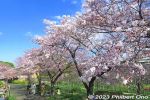
These were still one or two days before peak bloom.
|
|
|
|
|

Hanami picnic under the America cherry blossoms. Feeling the Spirit of America.
|
|

A long cycling path goes along Shin-Shibakawa River and the America cherry blossoms.
|
|
|
|
|
|
|
|
|
|
|
|
|
|
|
|
|
|
|
|
|
|
|
|
|
|
|
|
|
|
|
|
|
|
|
|
|

This is the end of the "America" Somei-Yoshino cherry blossoms.
|
|

Go right for the front entrance.
|
|

The museum is a large, two-story, Japanese-style house donated in 1997 by the family of Fukumoto Choemon (1881-1970) who emigrated to California and became successful and rich enough to build this house after returning to Japan. The museum opened in 1999.
|
|
|

The museum is a spacious Japanese-style house.
|
|

The museum is full of panel exhibits, mementos, artifacts, old books, and scrapbooks. It had a lot more than I had expected.
|
|

The museum staff person there could immediately tell that I was from Hawai'i even though I had said little more than "Hello" in fluent Japanese.
|
|

He knew immediately that I was from Hawai'i. That made me feel good actually, to know that I still haven't lost my Hawaiian traits even after living in Japan for many years.
|
|

Oar from the Hokule'a signed by Nainoa Thompson when they visited Suo-Oshima in May 2007. That was a big event for the island and the Hawaiian community in Japan. I saw the Hokule'a only when they arrived at Yokohama.The Hokule'a is a traditional canoe where they use only the stars, wave motions, and bird observations for navigation like they did in ancient times. Nainoa was a pioneer in resurrecting and mastering this ancient form of navigation. You can read about their adventures on Suo-Oshima here, from May 20:
|
|

People from Suo-Oshima were among the first boatload of Kan'yaku Imin immigrants to Hawai'i in 1885. They emigrated due to dire economic conditions on the island.
|
|
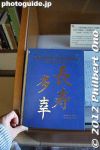
All the books in the museum are in open stacks where you can pull it out and read freely. Great for AJA researchers.
|
|

The scrapbooks and other delicate materials should be digitized though, something which they haven't done yet.
|
|

Old directory of all Japanese and Japanese-Americans living in Hawai'i. Never knew about this book.
|
|

The museum also has two rooms full of Japanese school stuff. One room is full of books, scrapbooks, etc., donated by Ichisaburo Nakamura. He was a member of the Hawaii Kyoiku-kai (education council) which developed and published Japanese school textbooks.One of his scrapbooks had group photos of the Hawaii Kyoiku-kai who met every summer. I could recognize some of the faces. They were mainly Japanese school principals/teachers in Hawai'i. I spent a good amount of time in that room alone. Another room displayed old Japanese school textbooks including those published in Japan. I remember some of them from Japanese school and UH Manoa. Amazing to see all of them in one room.
|
|
|

View of Suo-Oshima from the 2nd floor of the museum. The island is quite well populated with houses and fishing ports in many locations.
|
|

"The Art of Gaman" is an exhibition of art and crafts created by Japanese Americans incarcerated in Japanese internment camps in the US during 1942-46.
|
|
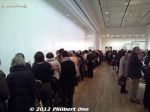
They used whatever scrap materials they could find to create these very imaginative and intricate works of art. "Gaman" basically means "to endure hardship."I wonder why the exhibition's Japanese title does not use the word "gaman." It instead uses the word 尊厳 (songen) which means dignity.
|
|
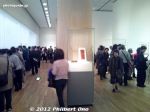
The exhibition drew large crowds in Tokyo.
|
|

Toy train made of scrap metal. In the front is a caster wheel, perhaps from a chair.
|
|
|

Chess
|
|
|
|

Created with scrap wood.
|
|

Pair of cranes made of scrap wood. There were other wooden sculptures of a lion, cow, snake, and boar, all from scrap wood.
|
|

One glass case showed these brooches made of shells.
|
|

Brooch made of small shells. Shells were found when they dug into the ground. Apparently, the desert was once covered by ocean.
|
|
|

The artist of some of the works was unknown.
|
|

Heart Mountain, Wyoming.
|
|
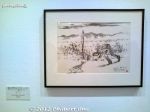
Drawing of someone getting shot by an MP.
|
|

Drawing of a dust storm entering the barracks.
|
|

Santa Fe camp on wood.
|
|

Santa Fe camp on wood.
|
|
|

Embroidered signatures.
|
|

Barrack model made of toothpicks.
|
|

Buddhist altar made with scrap materials. The top roof was made of tree bark.
|
|

Wooden sword and sheath.
|
|

Geta clogs.
|
|
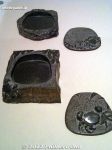
Ink wells made of stone.
|
|
|

I was surprised to see so many Japanese things made at a time when anti-Japanese sentiment was rampant. Butsudan, chopsticks, geta, swords, and these Japanese dolls.
|
|
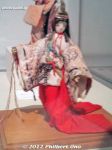
It is obvious that they still had a very strong attachment to Japan and their cultural heritage despite Japan being the "enemy."
|
|

In an adjacent room, they showed a short documentary previously aired by NHK TV. Unfortunately, they did not sell an exhibition catalog unlike in the States where they had one in English for sale (also available at Amazon).With all this interest in Japan, I hope they will be able to show it in more cities here (and in Hawai'i). I'm told that this exhibition in Tokyo is pretty much the same as the one at the Smithsonian American Art Museum in 2010. See their site for more (and clearer) photos of the art works: http://americanart.si.edu/exhibitions/online/gaman/index.cfm Geidai: http://www.geidai.ac.jp/museum/exhibit/2012/gaman/gaman_en.htm
|
|

Here's Supply Gate No. 5 at Yokota Air Base. It looked like a long wait here too, but it went smoothly.
|
|

Massive crowd going through the gate at Yokota Air Base. We were advised not to bring large bags. I only had a waist pouch. They inspected large bags and rucksacks. Foreigners had to show a photo ID. Of course, I look Japanese, so no ID check for me.
|
|

Poster for the Yokota Air Base Japanese-American Friendship Festival 2009. Free admission. You had to be either a Japanese or American citizen. (I happen to be a US citizen.)
|
|

Here we are in Yokota Air Base passing by numerous hangars.
|
|

The Japanese loved to take pictures with the Americans.
|
|

Basketball court
|
|

A long line to take pictures with a dog.
|
|

K-9 Unit posing for photos with a German Shepherd. That's a big doggie.
|
|

The festival's main area was lined with food booths and PEOPLE!! This is a lot more people than I had ever seen at this festival, and this was my third time. About 100,000 people came this day. Looked more like 500,000.
|
|
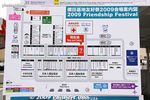
Layout of the place. Lots of food booths and souvenir stalls.
|
|

Entertainment schedule. There was an indoor stage inside Hangar No. 15 and an outdoor stage. Plus airborne demos.
|
|

Hangar 15
|
|

Hangar 15
|
|

Hangar 15 had an indoor stage and food booths. A good place to sit and rest. It wasn't so hot, like I remembered before. I was told that this hangar is normally used for the C-130.
|
|
|

The entertainment when I was there was the "Tanabata Dancers." Good to see these military wives embracing Japanese culture. Tanabata is the star festival for which host city Fussa is also famous.
|
|

One food booth was "Sons of Hawaii," run by people from Hawaii. Maybe they should change their name to "Sons and Daughters of Hawaii" cuz I saw mostly daughters. BBQ pork sticks and cupcakes. How come neva have Haw'n food??Kalua pig, poi, lomi-lomi salmon, and haupia. C'mon guys, bring out da real Hawaiian food. (If you guys really from HI.)
|
|

Many food booths had long lines. Sasebo Burgers here.
|
|

T-shirts
|
|

Cub Scout T-shirts, better design.
|
|

Mrs. Yokota?? Hmm, maybe she's married to a Mr. Yokota. Actually, she's Heather Fife, wife of Maj. Kurt Fife, 36th Airlift Squadron,like an ambassador for Yokota. Read about her here.
|
|
|
|

An American icon, SPAM.
|
|

They even had a race car display. They must've been happy that it didn't rain. There was some cloud cover, so it wasn't an unbearably hot day.
|
|

Hot rods
|
|

The black Camaro was on sale.
|
|

Dunking contest. Hey, where's the bikini girl?
|
|

Inflatable rides for kids, a long line as well. Very important to have something for kids. Lotta families came to the festival.
|
|

A giant food court on the tarmac. Good idea to bring something to sit on. Lucky that it wasn't a bright sunny day. Otherwise, the tarmac would be like a frying pan.
|
|

Would you believe an ambulance made its way through the food court?? People had to get up and make room.
|
|

Outdoor stage had more entertainment.
|
|

Hummer
|
|

Hokusai ukiyoe on the tail of a Cessna.
|
|
|
|
|

When you walk further down, you see the static displays of miltary aircraft.
|
|

On the left side were mostly helicopters and cargo aircraft.
|
|
|

On the right side, were mostly fighter planes.
|
|

Besides Yokota, these planes came from various places such as Kadena (Okinawa) and Misawa (Aomori) Air Bases.
|
|

I'm not an expert at military aircraft. I can only tell you the names of the most famous ones.
|
|

F-16 Fighting Falcon
|
|
|
|

The pilots or staff were on hand selling patches, T-shirts, etc.
|
|

This one stood out, like a swank sports car. Looks like a fast critter.
|
|

Fightin' Samurai T-shirt
|
|

Pilot's name
|
|

F-15 Eagle fighter
|
|

Fighter pilots always look quite intelligent. A college degree is required.
|
|

This plane, they allowed people to look inside the cockpit. A long line for this.
|
|

Climb up to see the cockpit. "Wow, awesome!"
|
|

F-22 Raptor, the stealth fighter. They had two of them on display. They came from Langley Air Force Base in Virginia. Next time, I'll ask them what it takes to become a stealth fighter pilot.
|
|

F-22 Raptor, the plane that Japan wants, but US bans its export. As a US and Japanese taxpayer, I paid a part of the cost of all the planes on display. Doesn't that make me a part owner?
|
|

F-22 Raptor, the stealth fighter. I thought the plane was black, but they are dull gray.
|
|
|
|
|

Planes with the familiar red dot belong to Japan's Self-Defense Forces. Japan Air Self Defense Force Mitsubishi F-2 fighter.
|
|

Japan Air Self Defense Force F-4 Phantom
|
|

Most of the Japan Air Self-Defense Force planes took off later in the day. Most of the US planes from outside Yokota left the next day.
|
|

Japan Air Self Defense Force Kawasaki C-1
|
|
|

P-3 Orion
|
|

AWACS plane
|
|

C-130 on the runway to take off for an airborne demo.
|
|
|

Three C-130 Hercules cargo planes start to take off one after another for an airborne demo.
|
|

C-130 taking off.
|
|

Some time later, the three C-130 planes dropped several men in parachutes.
|
|

Men in parachutes heading toward Yokota Air Base. They landed on the runway area.
|
|

Parachutes in the air.
|
|
|
|

After a job well done, the three C-130s return to Yokota Air Base.
|
|
|

C-130 landing at Yokota Air Base. These planes drew large crowds as they took off and landed. There are many aircraft fans in Japan, photographers crazy about military aircraft.
|
|

On the farthest end of the festival site were the two biggest planes on display. The C-17 Globemaster III (left) and C-5 Galaxy (right).
|
|

C-5 Galaxy transport plane, one of the largest aircraft in the world. One of my favorites.
|
|

C-5 Galaxy transport plane was fully open for public viewing. We could just walk through the plane's cargo hold. No lines of people.
|
|

This C-5 Galaxy came from Travis Air Base in California. Its gaping mouth open for visitors. I like the design of this plane. It's nice.
|
|

This baby can carry a lotta stuff. It can swallow a helicopter whole. Can you believe the C-5 has been in service since 1969? That's 40 years ago! Happy birthday!
|
|
|

People could also sit and rest inside the C-5 Galaxy.
|
|

Floor of the C-5 Galaxy, dotted with eyelets for hooks or ropes to secure the cargo.
|
|

Exit of the C-5 Galaxy. The plane's openings on both the front and back enables unloading and loading to be done at the same time.
|
|

Inside the C-5 Galaxy, selling T-shirts, "Size does matter."
|
|

The C-5 Galaxy has 28 wheels.
|
|

C-5 Galaxy engine
|
|

Side view of the C-5 Galaxy's front end. The closest thing we have to Thunderbird 2.
|
|

These people are lining up to see the C-5 Galaxy's cockpit on the upper deck.
|
|

Lining up to see the C-5 Galaxy's cockpit on the upper deck. There are some passenger seats as well.
|
|

At the mouth of the plane is this ladder going up the cockpit of the C-5 Galaxy.
|
|

C-5 Galaxy crew
|
|

Next to the C-5 Galaxy was the second largest plane on display: The C-17 Globemaster III. This plane came from Hickam Air Force Base in Honolulu, Hawaii.
|
|

Front and nose of C-17 Globemaster III
|
|

C-17 Globemaster III
|
|

C-17 Globemaster III
|
|

C-17 Globemaster III and C-5 Galaxy cargo planes
|
|

People also lined up to sit in the cockpit of the C-17 Globemaster III. Unfortunately, I didn't have time to line up and see the cockpit of any of the planes.
|
|

C-17 Globemaster III has only one opening (in the rear) for loading/unloading cargo.
|
|
|
|

We could also enter the C-17 Globemaster III from the rear.
|
|

Entering the C-17 Globemaster III cargo plane.
|
|

Inside the C-17 Globemaster III. I could almost smell the Hawaiian air. A few people from Hawaii were inside the plane selling souvenirs, greeting people with "Aloha!"
|
|

Engines of the C-17 Globemaster III.
|
|

Next to the C-17 Globemaster III was this refueling plane called the KC-135 Stratotanker made by Boeing.
|
|

The KC-135 Stratotanker has been in service since 1957.
|
|

People could also enter the KC-135 Stratotanker.
|
|

Young Tigers on the tail of this KC-135 Stratotanker.
|
|

Below the tail is the refueling pipe (with fins) of the KC-135 Stratotanker.
|
|

Entering the KC-135 Stratotanker.
|
|

Sky-colored C-130 of the Japan Air Self-Defence Force.
|
|

We could only peek inside Japan's C-130.
|
|

A long line to enter the C-130 Hercules plane.
|
|

C-130 Hercules.
|
|
|

C-130 nose
|
|

Girl in yukata kimono posing with military persons in uniform in front of the C-130.
|
|
|
|

I wish they had signs in front of each plane so we can identify the plane and know where it came from.
|
|

Torii at Yokota Air Base. I remember that there was a control tower back here. Not there anymore. In fact, I couldn't find the control tower anywhere.
|
|

Torii at Yokota Air Base.
|
|

They should understand that the samurai was a land-based fighter. They never flew in the air.
|
|

Japan Air Self Defense Force, U-125A
|
|

Long lines almost everywhere.
|
|

Now for the helicopters. A bunch of them were on display, including this Huey.
|
|

People lined up to sit in the cockpit of the Huey helicopter.
|
|
|
|

Chinook helicopter
|
|
|
|

Interesting shape of the rotor blades.
|
|

So what's the difference between a green helo and a blue one (next photo)?
|
|

The green (camoflauge) one is for flying over land, the blue for ocean.
|
|
|

Trying on pilot's helmets.
|
|

In the afternoon at the outdoor stage, they had a Strongman's Competition.
|
|

This strongman pulled a bus loaded with kids.
|
|

Our fly boys on a lunch break.
|
|

On a garbage truck.
|
|

At around 2 pm, they started to clear people away from part of the aircraft display area. Some of the aircraft were to depart. This happens only on the second day of the festival.
|
|

The aircraft started departing at around 3 pm.
|
|

Fighter on the runway.
|
|

Helicopter taking off at Yokota Air Base.
|
|

We were then treated to a series of flybys by planes leaving Yokota Air Base. After each plane took off, they flew by us and did a few airborne tricks.
|
|

Deafening noise, but very dramatic and a great ending to a great friendship festival. Also see my YouTube video here.
|
|

Beechcraft
|
|

U-125A
|
|

Most of the planes leaving Yokota were from the Japan Air Self-Defense Force. a nice festival climax, but the festival wouldn't end until night time when fireworks were held.
|
|
|

The Chinook helicopter going to the runway to take off.
|
|

Chinook helicopter up and away.
|
|

The Yokota Air Base Japanese-American Friendship Festival in 2009 was great. I really enjoyed it. So much to see. The variety of aircraft was excellent. Obviously, a lot of preparation went into this festival with aircraft coming from many bases.
|
|

Thanks to all who made it possible. Make no doubt, I am a proud American (from Hawaii), and always happy to see activities and events promoting better friendship and relations between the US and Japan.
|
|

Train for kids plied between the gate to the main festival site.
|
|

Toilets, both American and Japanese style. They had many portable toilets on hand. And they were busy all day long.
|
|

Crowd going home. This was around 4:30 pm. There were still people entering the base, probably for the fireworks later in the evening. But I went on to Mitaka to see the Awa Odori.
|
|

Exit at Supply Gate No. 5, was terribly crowded. The gate wasn't the problem. The problem was the street traffic signal beyond. We had to wait for it to turn green several times. They should've just closed the road to traffic.
|
|
|
|
|